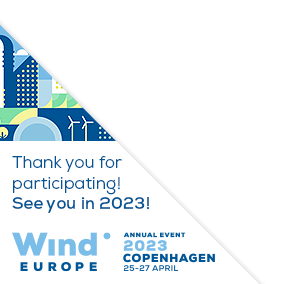Posters
Siblings:
ProceedingsProgrammeSpeakersPostersContent PartnersGlobal Markets TheatreWindTalks for InnovationProgramme Committee & Abstract ReviewersSpeaker's DashboardCome meet the poster presenters to ask them questions and discuss their work
Check the programme for our poster viewing moments. For more details on each poster, click on the poster titles to read the abstract. On Wednesday, 6 April at 15:30-16:15, join us on Level 3 of the Conference area for the Poster Awards!

PO141: Development of MOST, a fast simulation model for optimisation of floating offshore wind turbines in Simscape Multibody
Massimo Sirigu, Phd student, Politecnico di Torino
Abstract
HAVING RELIABLE AND FAST NUMERICAL MODELS FOR SIMULATING THE SYSTEM BECOMES IMPERATIVE TO ENSURE OPTIMAL PLATFORM DESIGN. THESE MODELS MUST BE ABLE TO CALCULATE THE MOVEMENTS OF THE PLATFORM, THE MECHANICAL STRESSES ACTING ON THE COMPONENTS AND ASSESS ENERGY PRODUCTIVITY WITH THE REQUIRED ACCURACY. THIS ARTICLE PRESENTS A NEW NON-LINEAR TIME-DOMAIN MODEL WRITTEN IN MATLAB-SIMULINK ENVIRONMENT FOR THE CALCULATION OF THE FUNDAMENTAL QUANTITIES OF THE FLOATING WIND TURBINE, TAKING INTO ACCOUNT MULTIBODY DYNAMICS IN SIX DEGREES OF FREEDOM, AERODYNAMIC FORCES, HYDRODYNAMICS OF THE FLOATING PLATFORM, AND MOORING CHAINS. THE RESULTS ARE THEN COMPARED WITH FAST TO VERIFY THE ACCURACY AND SIMULATION TIME. THE CASE STUDY FOR COMPARISON REPRESENTS THE 5 MW REFERENCE TURBINE DEVELOPED BY NREL, MOUNTED ON THE OC3 HYWIND SPAR. THE COMPARISON WAS MADE BOTH ONSHORE AND OFFSHORE. THE QUANTITIES TAKEN INTO CONSIDERATION ARE THE POWER PRODUCED, THE THRUST FORCE AND THE TORQUE ON THE ROTOR, THE BLADE PITCH, SURGE AND PITCH MOVEMENT OF THE PLATFORM. The simplification of the wind turbine aerodynamics through look-up tables using pre-calculated values is a big advantage for reducing the simulation time. In fact, the simulation time of the Simulink model is an order of magnitude lower than FAST (about 15 times less). Reducing simulation time is essential to be used in an optimization algorithm such as the dimensioning of the floating platform, the optimization of the turbine control system and integrated wave energy converters. The results of the model show a good adaptation compared to the FAST results, being able to affirm that the approximations made are acceptable for a preliminary analysis.










Follow the event on: